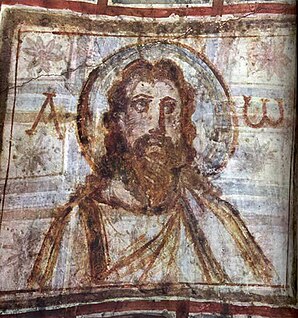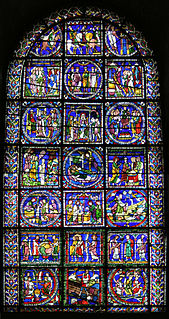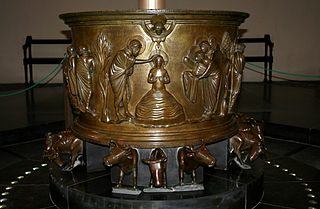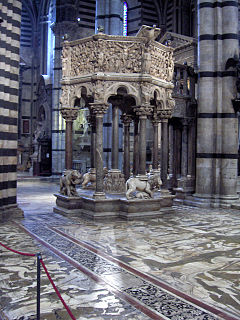
Infant baptism is the practice of baptising infants or young children. Infant baptism can be contrasted with what is called "believer's baptism", which is the religious practice of baptising only individuals who personally confess faith in Jesus, therefore excluding underage children. Infant baptism is also called christening by some faith traditions.

The depiction of Jesus in pictorial form was controversial in the early Church. The depiction of him in art took several centuries to reach a conventional standardized form for his physical appearance, which has subsequently remained largely stable since that time. Most images of Jesus have in common a number of traits which are now almost universally associated with Jesus, although variants are seen.

St. James Cathedral is a Roman Catholic cathedral located at 804 Ninth Avenue in the First Hill neighborhood of Seattle, Washington, United States. It is the mother church of the Archdiocese of Seattle and the seat of its archbishop, currently Paul D. Etienne. The cathedral is named for St. James the Greater, patron saint of the archdiocese, and is the third church in the territory presently known as the Archdiocese of Seattle to bear the name.

The Tree of Jesse is a depiction in art of the ancestors of Jesus Christ, shown in a branching tree which rises from Jesse of Bethlehem, the father of King David. It is the original use of the family tree as a schematic representation of a genealogy.

The Church of St. Trophime (Trophimus) is a Roman Catholic church and former cathedral located in the city of Arles, in the Bouches-du-Rhône Department of southern France. It was built between the 12th century and the 15th century, and is in the Romanesque architectural tradition. The sculptures over the church's portal, particularly the Last Judgement, and the columns in the adjacent cloister, are considered some of the finest examples of Romanesque sculpture.

The term Poor Man's Bible has come into use in modern times to describe works of art within churches and cathedrals which either individually or collectively have been created to illustrate the teachings of the Bible for a largely illiterate population. These artworks may take the form of carvings, paintings, mosaics or stained-glass windows. In some churches a single artwork, such as a stained-glass window, has the role of Poor Man's Bible, while in others, the entire church is decorated with a complex biblical narrative that unites in a single scheme.

The Epitaphios is a Christian religious icon, typically consisting of a large, embroidered and often richly adorned cloth, bearing an image of the dead body of Christ, often accompanied by his mother and other figures, following the Gospel account. It is used during the liturgical services of Good Friday and Holy Saturday in the Eastern Orthodox Churches, as well as those Eastern Catholic Churches, which follow the Byzantine Rite. It also exists in painted or mosaic form, on wall or panel.

The Life of Christ as a narrative cycle in Christian art comprises a number of different subjects narrating the events from the life of Jesus on Earth. They are distinguished from the many other subjects in art showing the eternal life of Christ, such as Christ in Majesty, and also many types of portrait or devotional subjects without a narrative element.

The baptismal font at St Bartholomew's Church, Liège is a Romanesque brass or bronze baptismal font made between 1107 and 1118 now in St Bartholomew's Church, Liège in Liège, Belgium. The font is a major masterpiece of Mosan art, remarkable for the classicism of its style, whose origin has been the subject of great debate among art historians. The Meuse river valley in modern Belgium and France, roughly coterminous with the Diocese of Liège, was the leading 12th-century centre of Romanesque metalwork, which was still the most prestigious medium in art.

The Dura-Europos church was the earliest-identified Christian house church. It was located in Dura-Europos, Syria, and was one of the earliest-known Christian churches, and seems to have occupied an ordinary house that was converted for worship some time between 233 and 256. In 256, the town was abandoned after the Persian siege. It was less famous, smaller, and more-modestly decorated than the nearby Dura-Europos synagogue, though there are many similarities between them.

The Siena Cathedral Pulpit is an octagonal structure in Siena Cathedral sculpted by Nicola Pisano and his assistants Arnolfo di Cambio, Lapo di Ricevuto, and Nicolas' son Giovanni Pisano between the fall of 1265 and the fall of 1268. The pulpit, with its seven narrative panels and nine decorative columns carved out of Carrara marble, showcases Nicola Pisano's talent for integrating classical themes into Christian traditions, making both Nicola Pisano and the Siena pulpit forerunners of the classical revival of the Italian Renaissance.
The Holy Week in Braga is the most imposing, attractive and famous among all in Portugal, and the most important tourist and religious event in the city of Braga. It is estimated that about 100.000 people attend the major processions. It combines harmoniously elements of the liturgy and of popular piety, ancient traditions and innovation. Since November 2011, this event is officially “Declared of Interest to Tourism”.

Kippinge Church stands alone, midway between Vester Kippinge and Øster Kippinge in northwestern Falster, Denmark. It is west of Redslev wood. Thanks to three reputed miracles, the Early Gothic church attracted many pilgrims until the end of the 19th century. It is known for its rich Renaissance furnishings and its frescos from the mid-14th century.

The Liuthar Gospels are a work of Ottonian illumination which are counted among the masterpieces of the period known as the Ottonian Renaissance. The manuscript, named after a monk called Liuthar, was probably created around the year 1000 at the order of Otto III at the Abbey of Reichenau and lends its name to the Liuthar Group of Reichenau illuminated manuscripts. The backgrounds of all the images are illuminated in gold leaf, a seminal innovation in western illumination.

The Bernward Doors are the two leaves of a pair of Ottonian or Romanesque bronze doors, made c. 1015 for Hildesheim Cathedral in Germany. They were commissioned by Bishop Bernward of Hildesheim (938–1022). The doors show relief images from the Bible, scenes from the Book of Genesis on the left door and from the life of Jesus on the right door. They are considered a masterpiece of Ottonian art, and feature the oldest known monumental image cycle in German sculpture, and also the oldest cycle of images cast in metal in Germany.

The Bernward Column also known as the Christ Column is a Romanesque bronze column, made c. 1000 for St. Michael's Church in Hildesheim, Germany, and regarded as a masterpiece of Ottonian art. It was commissioned by Bernward, thirteenth bishop of Hildesheim. It depicts images from the life of Jesus, arranged in a helix similar to Trajan's Column: it was originally topped with a cross or crucifix. During the 19th century, it was moved to a courtyard and later to Hildesheim Cathedral. During the restoration of the cathedral from 2010 to 2014, it was moved back to its original location in St. Michael's, but was returned to the Cathedral in August 2014.

The Tomb of Bruno the Priest is grave monument, which is an outstanding example of Romanesque stonework and composition. It was set up after 1194 and is located on the south wall of the choir of Hildesheim Cathedral not far from the Thousand-year rose.

The Wrisberg Epitaph is a triptych, which was created by the Hildesheim painter Johannes Hopffe in 1585 as an epitaph for the Domherr Ernst von Wrisberg. The original frame does not survive. Of the panels, which were hidden during the Second World War, the central one could be viewed in the south transept of Hildesheim Cathedral until January 2010. During the renovation of the cathedral (2010–2014) the three panels were on display in a reconstructed frame in the Weserrenaissance-Museum in Schloss Brake, Lemgo.

The Sacramentary of Henry II, also called the Regensburg Sacramentary, is a manuscript of liturgical texts, which was created in Regensburg at the order of Emperor Henry II. It is among the most significant works of Ottonian illumination. The manuscript was gifted to Bamberg Cathedral by Henry II, was part of the Cathedral treasury until 1803 when it became part of the Bavarian State Library as a result of Secularisation. It remains there today, stored under the inventory number clm 4456. It is modelled on the Codex Aureus of St. Emmeram donated by Charles the Bald in 870.


























